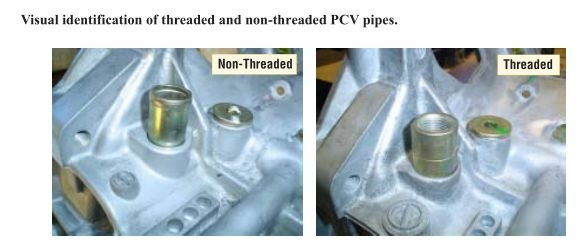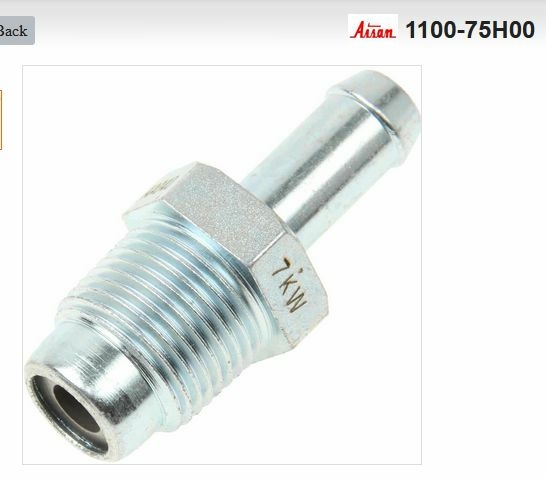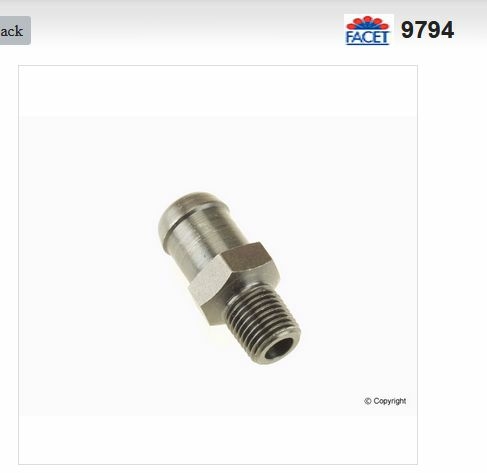
1197sts
Members-
Posts
104 -
Joined
-
Last visited
-
Days Won
4
Content Type
Profiles
Forums
Gallery
Store
Everything posted by 1197sts
-
Resurrecting an old thread. Another success using Trans X, I have a beater 2000 OB with about 280K miles, it had been running pretty well then started with the delayed engagement pattern, it was bad enough I wondered if I was going to have to get a new transmission. I added one 15oz bottle of K&W Trans X and it is vastly improved. BTW I am not a person who trusts snake oil, magic in a bottle, etc but this stuff works.
-
A quick leak check on the valves will tell you which ones are bent. As others have mentioned it is not unusual for all of them to be bent. Some will be obvious, some not so much. I have made this mistake myself, its no fun to pull the engine to replace the valves I missed the first time. As GD mentioned just replace them all.
-
I bought a JDM H6 for my son's 2001 LL Bean, it ran fine for a few thousand miles and is now pumping coolant into the overflow reservoir and has bubbles. There are plenty of people who have had good luck with the JDM engines, but from my perspective there is no way to know what you're getting with a JDM engine it is a gamble as far as headgasket longevity is concerned. When I purchased mine the seller documented a compression test, that's all the info you can usually get. Also from what I have seen prices are going up especially on the EZ30 the earlier version, shipping is going up, even if you do the labor yourself it is not what I would call inexpensive.
-
4eat dead?
1197sts replied to 1197sts's topic in 1990 to Present Legacy, Impreza, Outback, Forester, Baja, WRX&WrxSTI, SVX
I ended up changing the transmission, it runs well no issues. Thanks for the suggestions. As idosubaru mentioned dented pans can cause issues, the replacement tranny had a dented pan, initially it ran but was producing code 75 and was shifting poorly. It ended up being the Line Pressure Duty Solenoid, also called Duty Solenoid A. It looked like the pan broke the connector to the solenoid when it was dented. I replaced the solenoid and its running well. -
I have a 2000 OB AT (4EAT), I think I have a bad transmission but would appreciate any ideas before I pull it. It began having some slight shifting problems a couple of months ago, it would hesitate it downshift on acceleration, and not a smooth shift. I changed the TPS and it seemed to help, not i'm not sure it did any good. Then just 2 days ago I had delayed engagement, both in reverse and drive. Up until yesterday it would still drive, got a lot worse in a hurry. It began shifting very poorly and not sure it was even shifting into all gears. It has no AT Temp light so no transmission codes. Occasionally I get a CEL P0732, not consistently. Yesterday I put in a different transmission computer, and the day before I put in a different TPS and adjusted it to .5v. This morning I drained the ATF, it wasnt too bad as far as discoloration, very little sludge or pieces. ( I have done regular fluid changes in the past). After the fluid change it will not go into gear at all, fwd or reverse. This sure seems to be mechanical, is there a possibility this could be electrical, like a bad solenoid, bad ground, broken wire, etc. I have had lots of 4eat cars, typically the delayed engagement can be tolerated for a long time, and I have used the trans x additive which sometimes helps, I am surprised how quick this had deteriorated. Seems to be more than seals leaking or a sticky valve.
-
I recently went through an extended period of troubleshooting a charging problem on a 2001 LL Bean (3 wire system). To make a very long story short it was a bad alternator. It started out intermittently with several warning lights flashing, eventually total loss of charging. When measuring voltage at the battery it should read approx 14 to 14.5 volts when initially started, and depending on load and state of charge will then modulate between approx. 12v to 14.5v. When we had the total failure the voltage while running was erratic, but less than 10v. There are people who have de pinned pin C (black/red wire), and the car electrical system works fine. Some say this is hard on the system, but apparently the internal voltage regulator in the alternator works just like the 2 pin systems in the 4 cyl cars where there is no signal at pin C which should produce approx. 14.5v with no problem. There is also some info floating around about a Subaru service bulletin for certain Foresters that changes the signal to the ECU, simulating a load, presumably to influence the signal at pin C. I have also read several reports of people trying to determine what the signal is supposed to be at Pin C, there does not seem to be a consensus on what the signal is supposed to be. There are tons of people that have had trouble fixing charging issues with the H6 I think a lot of it is due to not understanding the system. Also the aftermarket alternators have a bad reputation. Also I don't think the local parts store can do a good test on a 3 wire system, most don't know what it is.
-
Update, yesterday he finally got some time to work on the car, he jump started it and the voltage was way low and jumping around so he decided to try a rebuilt alternator. Today he installed it and it is working well so far. There are no warning lights on at the moment and the voltage seems normal. With the H6 alternator it is a little hard to tell whats going on, the ECU seems to adjust the charge voltage in a range from about 14.4vdc to about 12vdc based on what it senses load to be. I will feel a lot better about it after he has put some miles on it. BTW he is based at Camp Pendleton, he just found out he has a buddy with access to the auto shop so that will make a lot easier if he has other stuff he needs to work on.
-
Sorry for the delayed response. He has not had much time to work on it. He did check out the power distribution wiring and did not find anything. I recommended to him to get the alternator re checked, that is the next step and of course he needs to get his battery charged. For you who may not be aware, the H6 uses the ECU to control the alternator, it will vary the charge to the battery. The connector at the alternator has 3 wires going to it not two like the H4. The alternator output voltage will not be a steady 14 to 14.5v in all conditions. I have seen some reports there is a way to disable the ECU control over the alternator, apparently there is a Subaru Service Bulletin for certain models of forester but I don't have a lot of confidence in that until I get more information.
-
My son has a 2001 LL bean, it has been having intermittent electrical problems. In the beginning it only happened once in a while but its a lot worse now. When driving several of the panel lights will light up, it started out occasionally a "flickering light" now is fully on, typically it would be Charge, abs, and maybe more. The last time he drove it it acted like it was not charging, and of course it will eventually run down the battery in that case. sometimes the headlights don't work. I don't know if its related, the daytime running lights have not worked on this car since we bought it. What he has checked so far: Security of battery cables, checked all grounds he could find. Checked all fuses in engine bay including the SBF's, had the alternator checked, etc. It has not blown any fuses. Has swapped relays headlight relays no change. I am going to suggest he complete wring out the power supply distribution to start with, checking for continuity and shorts to ground. This is a little complicated, he is in the military and I am trying to talk him through this remotely, and electrical troubleshooting is new to him, so he's got a steep learning curve.
-
I am working on a 2001 Outback LL Bean doing some electrical troubleshooting. There are several black relays in the relay fuse box in the engine bay, and more in the relay panel below the steering wheel below the main fuse panel. They are made by Mitsuba japan. I have found some labeled RC-5001, and some labeled RC-5008. Are these interchangeable? They look like they should be, but the p/n difference makes me wonder. I realize there are lots of different relays in other locations just talking about the black ones.
-
I just put one in a 2001 LL Bean. The JDM replacements are a good option on the EZ30 engines. Shipping prices are getting quite expensive now, but not much you can do about that. Like previously mentioned, re-use your intake manifold and wiring, put in new seals, plugs, thermostat, where appropriate.
-
On the Outbacks , MY 2000 and 2001 have the PCV valve threaded into the intake manifold, with hoses connecting to the block, air box (sometimes) and the valve. The hose connection at the valve is approx 3/4 inch?.Starting with MY 2002 the PCV valve is threaded into the fitting located on the block and a single hose connects to the intake manifold, the hose is smaller, maybe 3/8 inch?. The valves are not the same. There was a mid year change and I have seen a couple of 01's with the later style. When doing engine swaps if you have a newer intake manifold and an older block or the opposite, the plumbing and or hoses or even the location of the valve may have been modified to make it work. In the attached picture shows the attach point on the block the non threaded is the older style, the threaded is the newer style
-
I have found this to be a common issue on 2nd gen Outbacks, most likely the forester is similar. If the oat is above 90 to 95f, going up a long hill with the A/C on the temp can rise even if everything is working normally. As others have mentioned turning off the A/C usually helps. If it goes up under these conditions on a small hill I would suspect the radiator. Of course you want to verify your cooling fans are working.
-
Thanks for the input, I appreciate it. I am planning on swapping intake manifolds, so the brake booster hose shouldn't be an issue. I actually am planning on doing the radiator just forgot to put it on the list. What are your thoughts on water pumps? I always change them on the EJ engines, do they hold up better on the H6?
-
My son just bought a 2001 LL Bean with the EZ30D. It has 229K on it and is overheating. It definitely looks like bad headgaskets after doing some troubleshooting. Other than that the car is pretty good mechanically. I have a lot of experience with EJ251's, but none with the H6. My plan is to put in a JDM engine, the question is what should I do the engine proactively before I put it in? I am thinking plugs, valve cover gaskets, oil cooler gasket, thermostat, belt tensioner and idler pulleys. I have read all about the issues with the timing chain tensioners, some say change the guides and tensioners, some say change everything, some say leave it alone. I am thinking it might be best to leave it alone, what would you recommend?
-
The FB25 is not immune from headgasket issues, a few months ago I swapped out one in a 2013 Outback (first year of the FB in the OB). They were getting quotes of 4k to 6k to do headgaskets. If you can find a low mile used engine at a good price it is a good alternative. The FB's also have the leaky cam towers that are pretty expensive to reseal.
-
I had this happen to me, the crank would not turn in either direction, I ended up splitting the case. If I recall correctly I could get to two of the flex plate bolts. Some people have suggested its easier cut the case with a sawsall to gain access to the other two bolts, the case is already unusable.
-
Unfortunately I did a job for a friend who needed a new engine in a 2004 OB, Cali emissions. It is an early PZEV, and was also sold in some of the New England states. The heads are different than a 251, the pistons are different, the exhaust ports are different (single port), so no way to swap a 251 where a 259 is installed, unless you take a 251 short block and swap pistons and re use the 259 heads. The valves are the same, for whatever that's worth.The exhaust is completely different as previously mentioned, 5 o2 sensors, etc and very rare (expensive). There were some 05 OB's that came with the 259 as well (Cali spec?). There isn't anything inherently wrong with the engine except its an odd ball and expensive.
-
Thanks el freddo, I have disassembled a couple of 251 heads in the past and there were some light scratches on the cam journals and cam itself. I think these can be cleaned up and reused no problem, but just wanted to see what others experiences are. On my 259 project, in addition to the original with a broken rod, I have sourced a core engine, it was running when pulled, low compression on #1 and #3. No rod knock according to the previous owner. I am probably going to harvest only the pistons and heads from this engine, so I should be good. BTW, I enjoy trying to determine what caused the failure on the blown engine. It was low on coolant, had oil everywhere including all over the bottom of the cross member, its is hard to say, but it may have had headgaskets leaking badly and finally ran low enough on oil that it fried the rod bearing. In addition to that is also high mileage, so the net effect of having a 7mm oil pump may have finally kicked in.
-
I have a similar situation, I am working on a 2004 Outback with an EJ259 that threw a rod, so the lower end is toast. I would like to install a EJ251 lower end and use the 259 heads. Will this work? Swapping pistons is not an option as the original 259 lower end is not usable and I don't have any other 259 pistons, and using 251 heads is not an option due to the single port exhaust. I have seen people speculate that it would be reduced compression but not much, can anyone verify that? One other question, when an EJ blows a rod, the oil system is contaminated. If I completely disassemble the head and clean out the oil passages in the head and the inside of the cam is it likely to be usable, does it usually do much damage to the cam bearing journals? Light enough damage a little scotch brite will do the trick?
-
Re: rear upper control arms on the Gen 2 Outbacks, I have found the easiest way to check them is: Jack up the car, put on jack stands. Reach up and grab the control arm. If the bushings are shot it will move around as you shake on it. BTW, the parts manual calls these upper later links, or something like that. When these are bad, you can have some very unpredictable handling , like abrupt fishtail going over bumps, or fishtailing when hitting icy spots. The bushings are replaceable or you can easily get these from the pick n pull. Re: the front control arm rear bushing it is expensive if you buy a new one, my local pick n pull charges less than 5.00 that's a pretty good solution. They are the elastomeric bearing (fluid filled), so look for ones that are not leaking and haven't chewed up the rubber spacers. They are not interchangeable left to right. If you still have clunks the transmission mount and rear diff bushings are trouble spots too.





